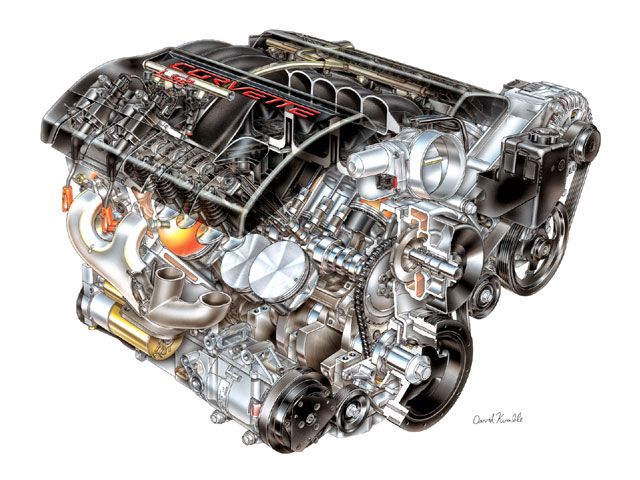
It's fitting that during the 50th anniversary year of the small-block Chevy, arguably its two greatest variations have been released. First, the 400hp 6.0L LS2 arrived for the '05 model year in the latest-generation Corvette, followed recently by the news of the giant-killer small-block: the 500hp 7.0L LS7 that will arrive this fall in the '06 Corvette Z06.
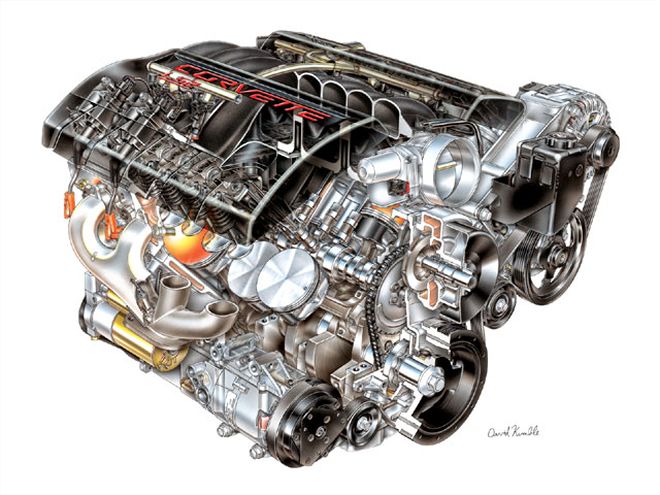 Illustration by David Kimble, courtesy of GM Powertrain
Illustration by David Kimble, courtesy of GM Powertrain
Looking back, the small-block engine design that debuted with 265 ci and 195 hp doesn't seem like much of a world beater, but in its day, it was a world-class engine with lightweight head and block castings and an overhead valvetrain that was ahead of its time. Today, we look at the latest LS6/LS7 engines and see race-inspired technology, including lightweight valves, cross-bolted main caps, and rollerized rocker arms. Back in 1955, Chevy's new small-block was just as revolutionary, and in those days, it too was regarded as being heavily influenced by racing technology, so its staggering racing success was pretty much a foregone conclusion.
GM actually refers to the current LS2 and LS7 as fourth-generation revisions of the classic design, although the only direct commonality all four generations share is the 4.400-inch center-to-center bore spacing. Since so many critical dimensions have changed over the years to the point that there are no interchangeable parts, it may be stretching the definition a bit to call these latest incarnations direct descendants of the engines that debuted in the '55 Chevy, but the fact that GM's bread-and-butter small-block V-8s still feature a cam-in-block design with pushrod-activated valves is enough for us to issue a pass on the subject.
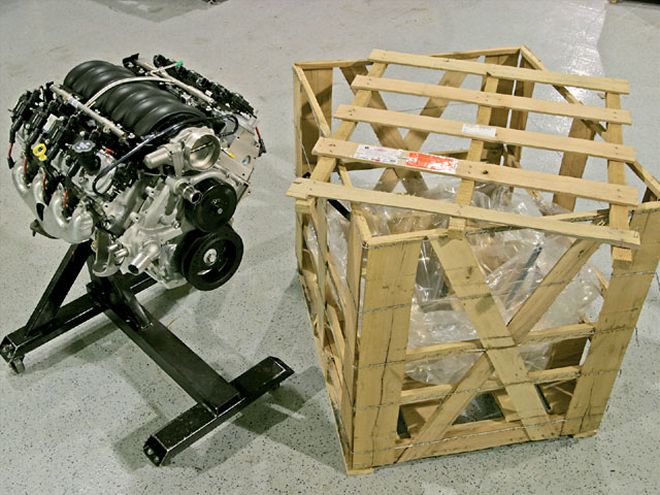 Out-of-the-box performance from GMPP means you can have a factory-direct LS2 shipped to your door for about $6,400. It comes with a standalone wiring harness and controller, but bolting it into anything that didn't originally come with at least a Gen III small-block is up to you to figure out.
Out-of-the-box performance from GMPP means you can have a factory-direct LS2 shipped to your door for about $6,400. It comes with a standalone wiring harness and controller, but bolting it into anything that didn't originally come with at least a Gen III small-block is up to you to figure out.
We asked Dan Nicholson, GM's chief engineer in charge of small-block and big-block engines, why the company has stuck with pushrods for all these years when so many other manufacturers have gone to overhead-cam designs.
"The pushrod [design] has the inherent advantage of compactness and a reduced number of components, and that will continue to be an advantage as long as we can continue to keep the cost, weight, and friction down and the valvetrain speed up to produce the power we need. That's what will continue to keep it in the ballgame," Nicholson told us, noting that typical customers are more concerned with the practical power and performance an engine delivers rather than the location of its cams or method of valve actuation.
"I think General Motors right now has a lot more credibility with regard to our overhead-valve pushrod engines being viable because we have the whole portfolio covered. Frankly, we were saying a lot of the same things in the '80s and '90s, but there was a skepticism because it was a little more like, 'Well, you're just trying to sell the stuff you have,' before we had outstanding overhead-cam engines like the Northstar, our new high-feature V-6, and our Ecotec four-cylinder engine," Nicholson says. "Now we've got all those engines, and yet this [LS2] is still a viable product. When we came out with the Gen III in the late '90s about the same time Ford came out with its modular V-8, some people thought, 'How can you compete with the Gen III?' The Ford guys thought we were nuts. Now here we are seven or eight years later and the marketplace has spoken, I think clearly, on that." Considering that no stock modular Ford V-8 has yet produced 400 hp without a blower, we can't disagree.
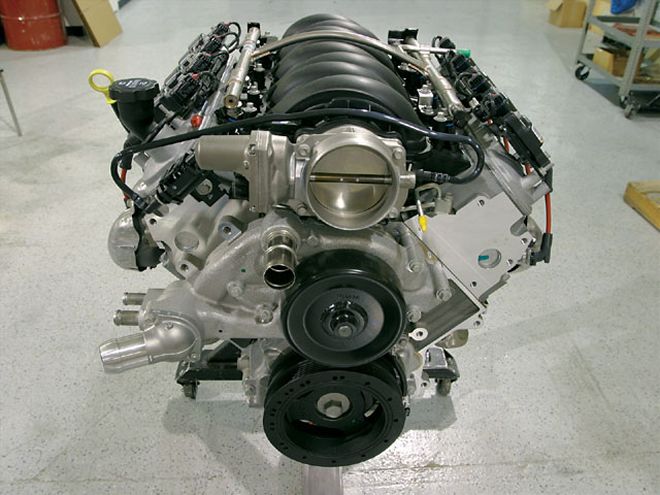 Compactness, simplicity, and durability are three hallmarks the latest Gen-IV small-block shares with its ancestors.
Compactness, simplicity, and durability are three hallmarks the latest Gen-IV small-block shares with its ancestors.
The LS2 is available now in the C6 Corvette, SSR roadster pickup, and '05 Pontiac GTO, and GM Performance Parts is already shipping LS2 crate engines to customers straight from the assembly line, so this new small-block should develop quite a following among enthusiasts right off the bat.
To see just how much the Gen IV design differs from its immediate predecessor, we asked for help from General Motors performance-engine guru Mark McPhail, who recently left GM to head up Katech's new street performance division. Anyone familiar with the racing career of the small-block Chevy in recent years is surely familiar with Katech's Le Mans-winning engines that powered the C5-R Corvette to multiple class wins in the annual 24-hour endurance race. Katech has been joined at the hip with GM Racing during its 20-plus-year history and has recorded race wins in Trans-Am, IRL, IMSA, and the NASCAR Busch series among others. McPhail and his colleagues at Katech are pretty far ahead of the curve in Gen III/IV development, having worked hand-in-hand with engineers at GM on numerous racing and R&D endeavors during development of the platform, and they had all the parts on hand, including a just-arrived GMPP LS2 crate engine.
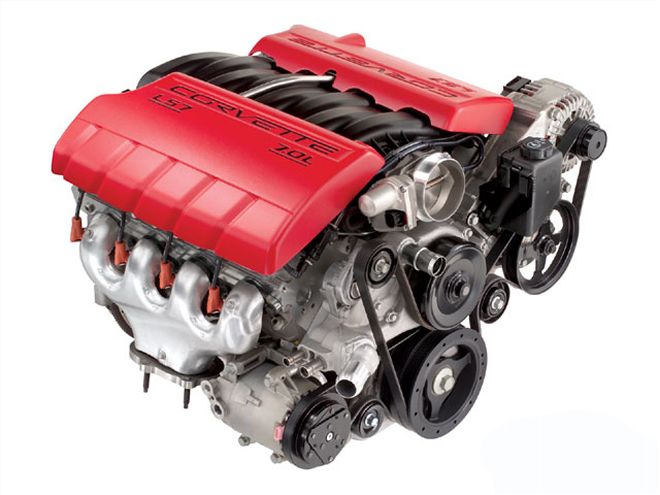 The new LS2 block casting displays its 6.0L displacement on the front of the case for easy identification. Gen-III blocks are marked on the back of the block.
The new LS2 block casting displays its 6.0L displacement on the front of the case for easy identification. Gen-III blocks are marked on the back of the block.
In this first of a two-part series, we'll dissect the major physical differences between the Gen III and Gen IV. In the second part, we'll strap that crate engine onto Katech's dyno and test several combinations of cams, heads, intakes, and exhaust manifolds to see just how well the new design responds to good, old-fashioned hot rodding.
The Ultimate 427 Small-Block Chevy
The number 427 is magic to Chevy fans, but who would have thought back in the day that the number would designate the cubic inches of a factory-produced small-block version of the Chevy V-8? Well, that day has come in the form of the 500hp LS7 engine that powers the upcoming '06 Corvette Z06 that was announced at the '05 Detroit auto show. Displacing a full 7 liters, the adage that "racing improves the breed" has never been more true than with this wicked engine, which features fully CNC-ported factory cylinder heads, an all-new, race-derived aluminum block, a forged crank, and get this: titanium rods and a dry-sump oiling system, both of which are firsts for a production GM vehicle. Developing 500 hp at 6,200 rpm and 475 lb-ft of torque at 4,800, the new LS7 is expected to power the newest high-performance Corvette into the 200-mph top-speed range and elevate it to the top echelon of the world's supercars.

Perhaps the most impressive feature of the LS7 is that it produces its prodigious power levels with a conventional-pushrod, cam-in-block, two-valve-per-cylinder architecture in a day when its exotic, mostly European competition has adopted far more costly and complex machinery to produce similar performance with similar displacement. Not only can GM make the power numbers, according to the company, the new Z06 will likely be the world's only 500hp car not to carry a government-mandated gas-guzzler tax thanks to its relative fuel-sipping economy. LS7s will be hand-assembled at GM's new Performance Build Center by teams of specially trained technicians, and we're told a crate version will shortly be available from GM Performance Parts. We've already scored an exclusive on the first one, so stay tuned for all the gritty details. Until then, check out these highlights.
LS7 Specs
Engine type: Cam-in-block 90-degree V-8
Block configuration: Cast aluminum with pressed-in cylinder sleeves and six-bolt, forged-steel main-bearing caps
Bore x stroke: 4.125 x 4.00 inches
Displacement: 427 ci
Crankshaft: Forged steel
Connecting rods: Forged titanium
Pistons: Cast aluminum
Compression ratio: 11.0:1
Cylinder heads: CNC-ported aluminum, 70cc chamber volume
Intake valves: Titanium, 2.20 inches
Exhaust valves: Sodium-filled, 1.61 inches
Camshaft: Hydraulic roller; 0.591-inch lift (intake and exhaust)
Rocker arms: 1.8:1; offset intake only
Air intake: Composite manifold with 90mm single-bore throttle-body
Fuel: 91-octane minimum
Horsepower: 500 @ 6,200 rpm
Torque: 475 @ 4,800 rpm
Redline: 7,000 rpm